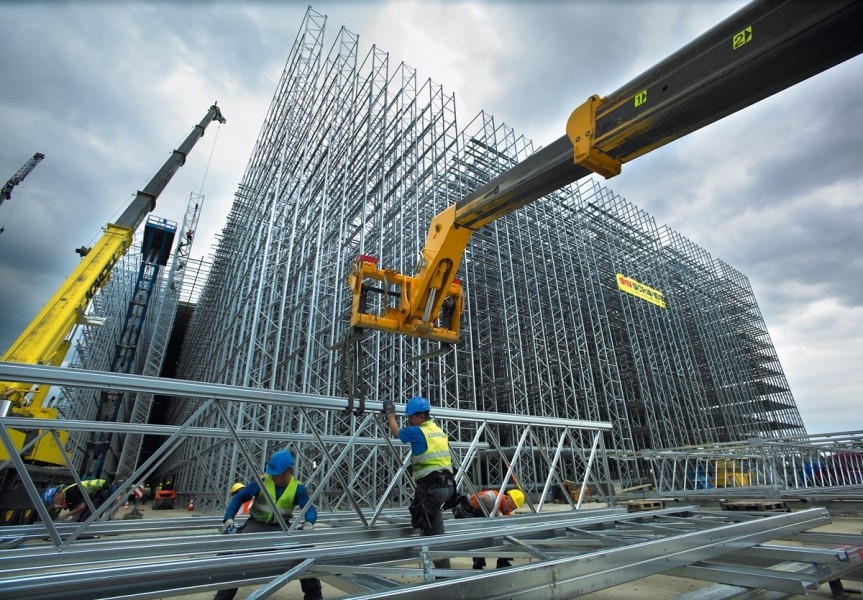 Photo: PIXABAY
Photo: PIXABAYThe previous year was characterised by activities prompted by large scale investments in Serbia’s construction sector – the value of the projects increased, as well as the number of employees and their incomes. Considering the record number of newly issued building permits, construction activities will continue to grow. However, considering hampered supply and very high and unstable prices of raw material currently challenging the construction sector, how will this crisis affect the pace of the ongoing projects, but also the black market – these are the questions we asked Ivana Vuletić, Secretary of the Association of the Construction Industry of the Serbia’s Chamber of Commerce and Industry (https://pks.rs/).

Ivana Vuletić, Secretary of the Association of the Construction Industry
The war in Ukraine caused great shocks in the construction industry, the prices of the construction material have drastically increased and supply chain shortage is getting worse every day. For all these reasons, the construction leaders announced their intention to ask for government’s support in this matter. Has this meeting taken place and are there any suggestions for ways to overcome this situation?
Initial major disruptions on the construction material market were caused by the Corona virus pandemics and had an impact on our market mostly at the end of the first quarter last year. This was the time when the steel price significantly increased in stock markets around the world, which was reflected on the concrete steel prices in the world, and consequently in our country, too. Thanks to, among other things, measures undertaken by the Government of Serbia to assist the companies affected by the pandemics, construction companies managed to overcome the price disturbances in the market.
The beginning of the war in Ukraine prompted new disturbances in the global stock markets, and therefore in our construction material market, too. The armature prices have doubled in just a few weeks time. Apart from the steel, bitumen and bitumen emulsion prices have gone up, as well as the prices of alluminium and PVC doors and windows, copper cables, brick material, timber...
Because of that, and following the market trends and construction activities, Serbian Chamber of Commerce approached the Ministry of Construction, Traffic and Infrastructure (MCTI) with a suggestion to arrange a meeting related to disturbances on the construction material market and their effects on the local construction business. The aim of the meeting would be to jointly search for an adequate proposal of the modes to introduce sliding scale in their ongoing and future contracts. Sliding scale implies an option of increase, but also decrease of prices, depending on the market trends.
The construction companies have also suggested to form a joint working team whose responsibility would be to formulate recommendations for the contractual provisions which will lead to overcoming possible unforeseen circumstances and to suggest methods for adjusting contract prices in signed contracts.
At the beginning of March this year, and with an aim to stabilise the production of ribbed steel and steel armature used in construction, we shared our suggestions with the office of the Prime Minister to intensify inspection controls and expedite imports of raw materials, namely scrap metal, which is the basic raw material in armature production.
An increase of the construction material prices inevitably leads to increased work costs, and subsequently, the price per square metre...
An increase in square metre prices was recorded long before the rise of the construction material prices. This has been an ongoing trend for the past few years, so I would like to avoid directly linking these two prices. At this moment, the growing trend of the square metre price is obviously driven by demand, which remains high, despite the high prices. We should also have in mind housing loans which are more affordable then before when it comes to the interest rate, which also a factor that affects the stability of the real estate demand.
How can this situation influence illegal labour?
The shortage of workforce in the construction business is, we may say, a lasting problem. In Serbia this problem is very pronounced, particularly due to the increased activity of the construction sector in the preceding period which led to an increased demand for workers.
In the forth quarter of 2021, a total of 167,687 persons were employed in the construction of buildings and other facilities and engaged in specialised construction works, including production of nonmetal mineral material, as well as in architecture and engeneering, which is 4.1% higher than in the same period the year before. Construction accounts for 7.5% of the total employment rate in Serbia. When it comes to specific sectors, 59,505 employees were recorded in specialised construction works, which is an increase of 1.7% in comparison to the last quarter of 2020. There were 32,668 employees (0.6% more) in the building construction, and 30,568 employees (9,1% more) in architecture and engeneering.
During the period from January to November 2021, the average salary in the construction sector was 77,477 dinars, which is 8,2% higher than in the same period of 2020. The highest average salary was in construction of other types of facilities, and it amounted to 102,148 dinars during the period from January to November 2021, which is 13.8% higher than the Serbian average salary, and 5.1 % higher than it was in the same period of the preceding year. In the sector of specialized construction works and buildings construction for the same period, average salaries were 29% and 16.2% lower, respectively, than average salaries in Serbia, while earnings in architecture and engineering were 9.5% above average.
In sum, earnings in construction sector in 2021 were higher by 5%, and at the end of 2021, in December, 2,916 building permits were issued, which is an increase of 34.3% compared to December 2020.
Apart from the shortage of the qualified labour, construction workforce is also facing the problem of a low number of students enrolling in the construction technical schools. Significant involvement of construction companies in the dual education system, would allow technical apprentices to prepare for work on the construction sites during the practical part of their education. Considering the ever increasing demand on the labour market, there is a continuous demand for workers in the construction business. Also, construction companies have come up with an initiative to establish training and retraining centres for construction workers, subsidised by the government.
What was the Serbia’s construction industry balance sheet last year, and are there any predictions for 2022?
The preceding year was marked by significant investment activities related to the construction sector, which participated with over 5 % in the Gross Domestic Product (GDP), while the value of works increased by as much as 35 %, and the number of workers by close to 10 %.
As a reminder, in the first quarter of 2021, the construction sector marked the highest year-over-year growth of the gross added value among all industries (19.6 % increase) when compared to the same period of the preceding year.
When it comes to the number of building permits issued, it is evident that the construction activities are expanding. According to the Republic Bureau for Statistics, 2,743 building permits were issued in March 2022, which indicates an increase of 35.2 % in comparison to the same period of the preceding year.
Having in mind the ongoing crisis in Ukraine, we cannot expect the continuation of an accelerated growth at the level reached in the past few years, but when it comes to the ongoing activity at the existing construction sites, we may be assured that the current projects will be implemented according to the agenda. The current crisis is unpredictable in terms of possible shortages and effects on prices of raw material, energy sources, various material apart from those used in construction, so we cannot come up with a general answer as to what is awaiting us in the upcoming period, only what we can conclude on the basis of the current situation. And in that respect – the construction industry keeps on working.
CONSTRUCTION MATERIAL SUPPLY PROBLEMS
According to the Serbian Chamber of Commerce report, concrete iron supplies have been reduced. Dealers have lowered the prices for the time being, but the prices of the steel armature are still extremely high and go as high as 1,200 EURO per tonne (as a comparison, on 01 March the price of the concrete steel was 762 EURO per tonne).
Dealers are requesting an advance payment, and their offers remain valid for 1-3 days. There is no guarantee of price, and the shortage of some goods is evident (4mm net is not available, there is a shortage of steel for the locksmith works). Some contractors have tried to import the steel armatures, considering that they can get a lower price per tonne, but the procedure is too complicated, and the transport costs are too high.
Brick and tile producers are concerned about the uncontrolled export of the best quality ceramic clay from Serbia. Ukraine used to be an important exporter of this raw material in the construction material industry, so the pressure on our country increased with the beginning of the crisis. Representatives of the leading Italian, Spanish, Polish, and Bulgarian producers in Serbia are trying to negotiate the procurement of large quantities of ceramic clay, offering prices considerably higher than the current market price. Local construction material industry is endangered.
By: Jovana Nikolić
Photo: pks.rs